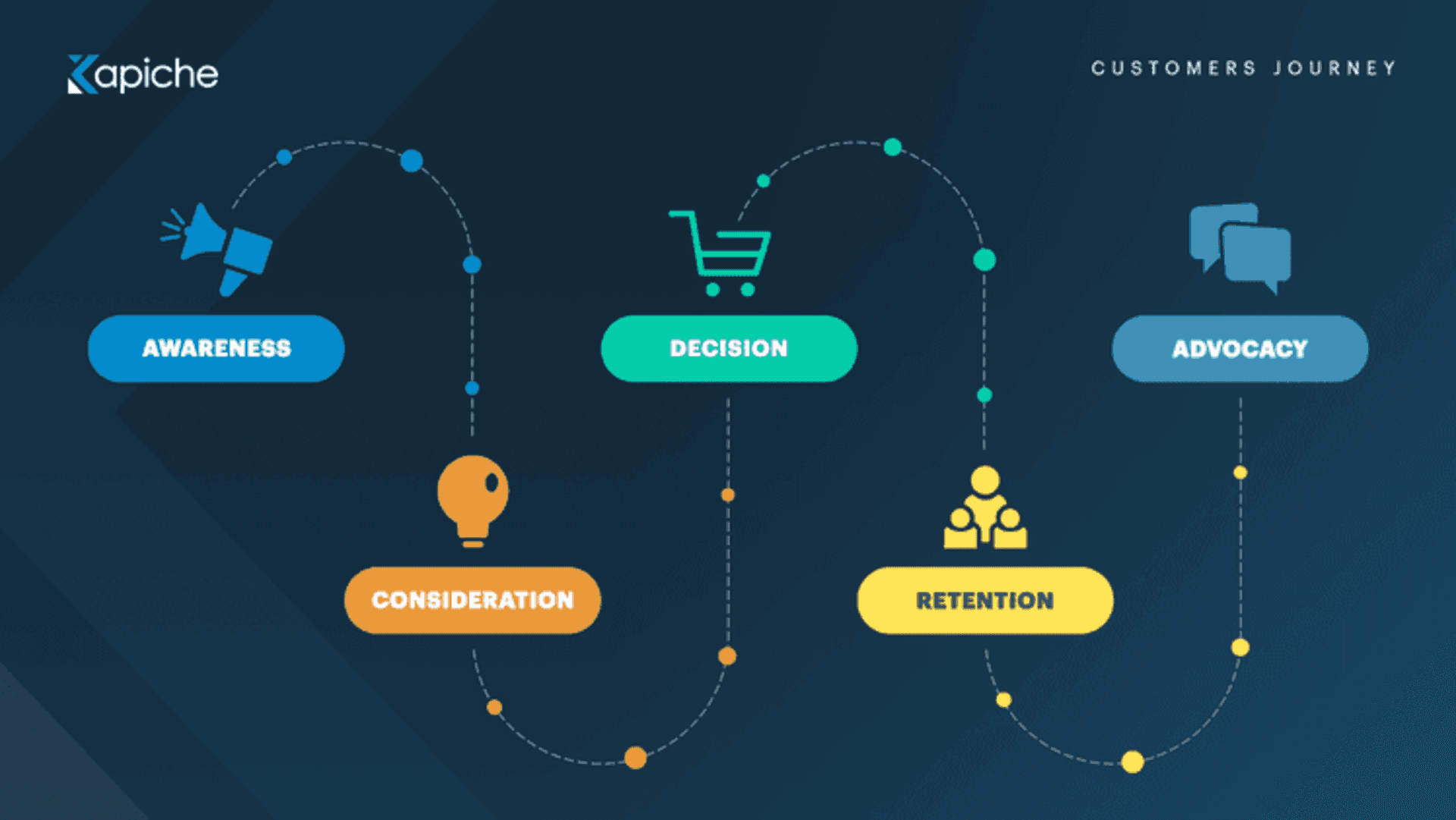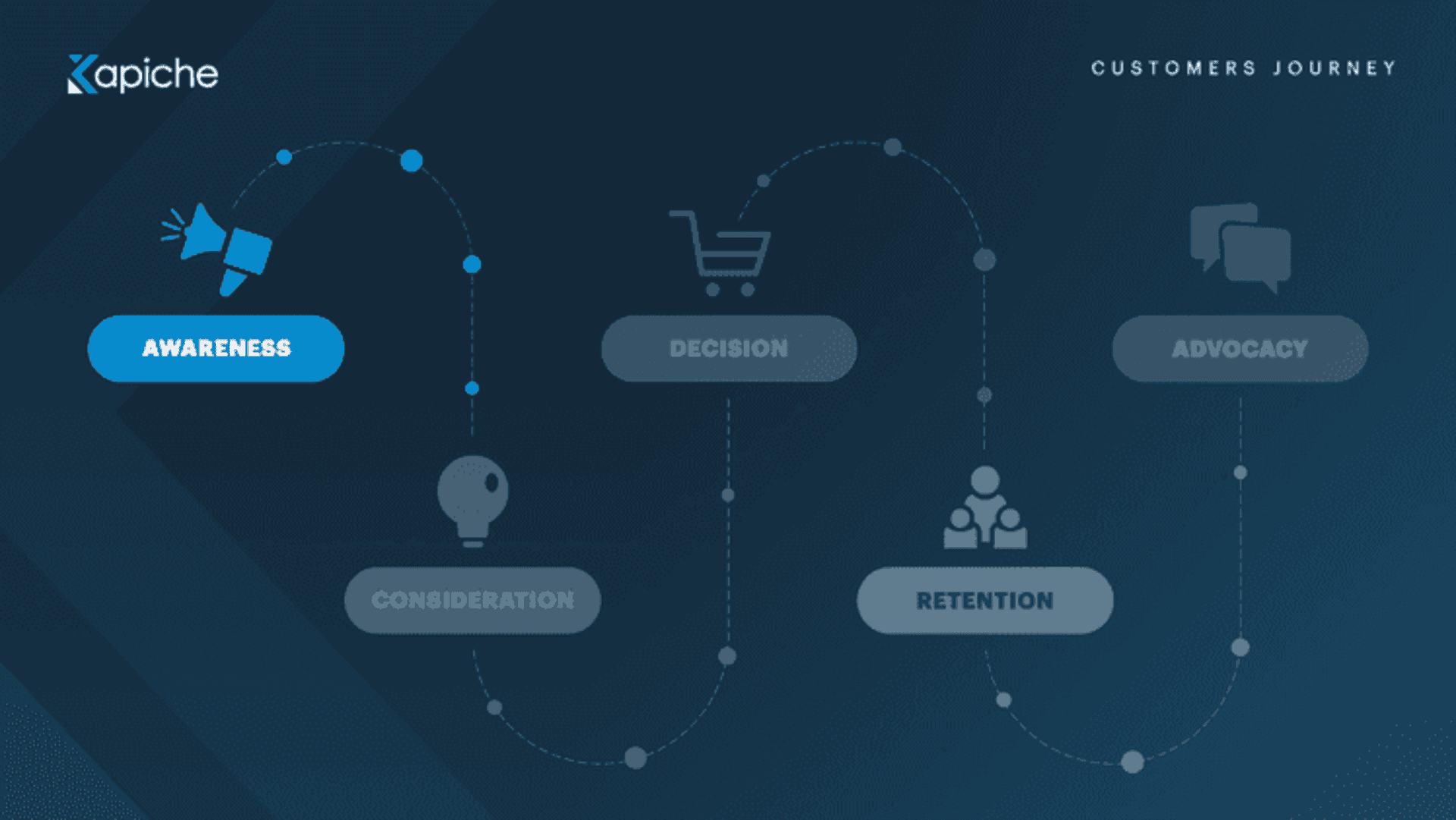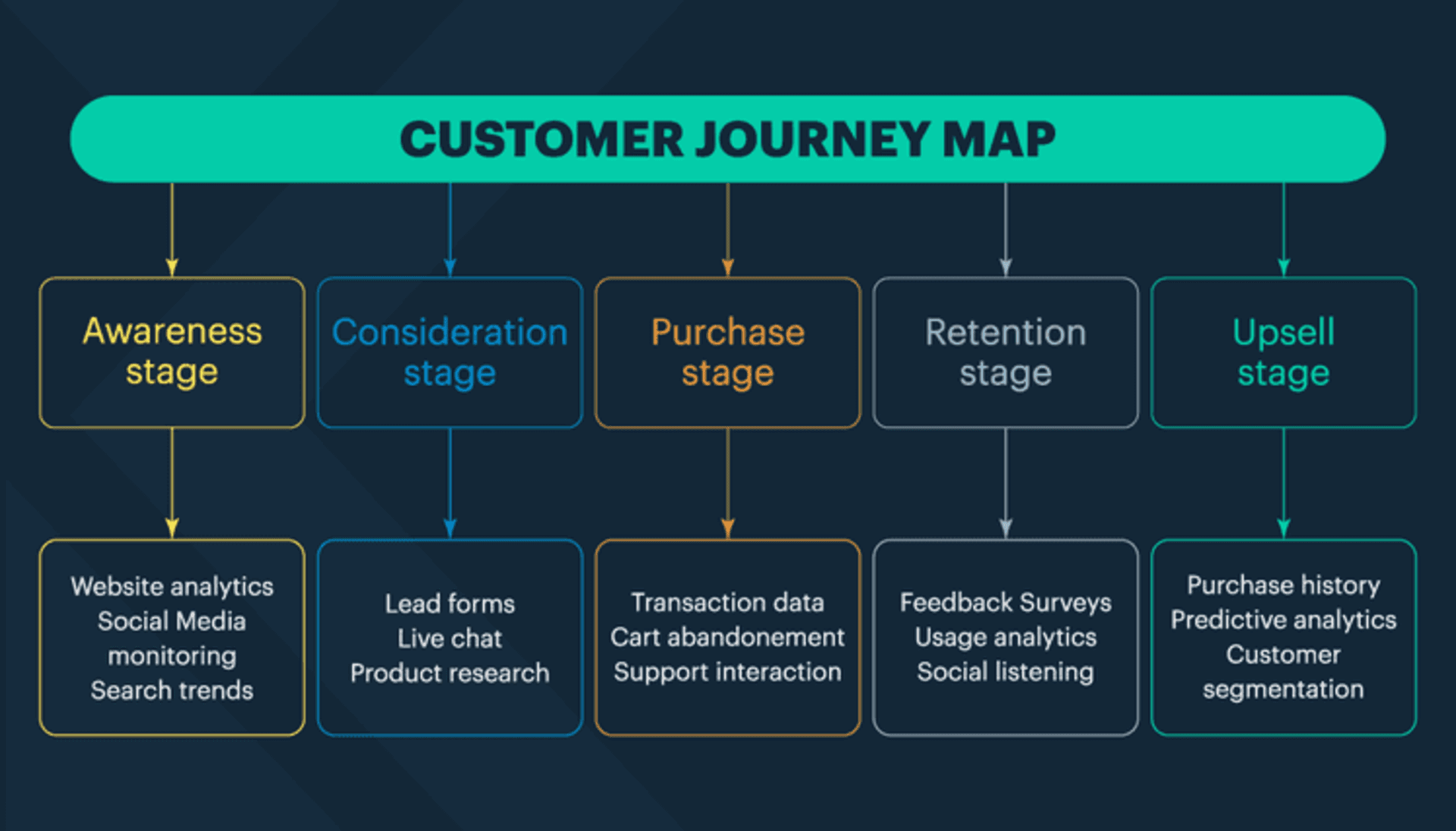If you’re in charge of any go-to-market activity, trying to stay on top of what your customers are feeling and doing is a constant juggling act. You need great monitoring systems and great data to understand their journey and experience with your brand.
It’s a tall order, especially when the goal is to transform insights and observations into actionable strategies that drive real results for your organization. Understanding and meeting customer expectations is crucial in this process, as it helps in fostering customer loyalty and encouraging advocacy.
One of the top tools at your disposal? Getting clarity on your customer journey stages. Each stage holds valuable clues about your customers’ needs and pain points. But without a clear map, it’s easy to miss these insights, leaving gaps in the customer experience and missed opportunities for improvement.
This article outlines the common stages in a customer journey, offering up some tips to map your own workflow and optimize experiences as you go.
What is a Customer Journey?
A customer journey is the complete sum of experiences that customers go through when interacting with your company and brand. It’s the roadmap of how they first become aware of your product or service, consider their options, make a decision, and eventually become loyal advocates. It’s the story of your customer’s relationship with your brand, from the first “hello” to the ongoing conversations that follow. Customer journey mapping is a crucial process for visualizing and understanding these experiences in detail.
Getting clear on your customer journey is essential. Why? Because every touchpoint, every interaction, every little moment your customer experiences with your brand contributes to their overall perception and satisfaction. In fact, 86% of buyers are willing to pay more for a great customer experience. Understanding and optimizing this journey can directly impact your business success.

Key Aspects of a Customer Journey
A customer journey includes all the customer touchpoints and channels that a customer uses to engage with you over time. These touchpoints are critical interactions that shape the customer's journey. As you can imagine, that’s a lot of touchpoints!
Here are some of the key aspects you should consider when thinking about what makes up a customer journey:
Touchpoints: These are the various points of contact between a customer and a brand, including advertisements, website visits, social media interactions, in-store experiences, customer service calls, and product usage.
Channels: Customers interact with brands through multiple channels, including digital (websites, mobile apps, social media) and traditional (in-store, phone) channels. An effective customer journey strategy must account for seamless transitions between these channels.
Emotions: The customer’s emotional state plays a crucial role in their journey. Positive experiences can lead to brand loyalty, while negative ones may result in churn.
What are the Customer Journey Stages?
Let’s dive into the core stages of the customer journey. Understanding each customer journey stage is essential for enhancing customer experiences. These stages help you understand where your customers are at any given point and what you can do to enhance their experience at each step.

1) Awareness Stage
This is where it all begins. The awareness stage is when potential customers first learn about your brand. They might come across your company through social media, a blog post, an ad, or word of mouth. It's all about catching their attention and making that crucial first impression.
Example:
A prospective customer sees an Instagram ad about your innovative new product. They're intrigued and decide to visit your website to learn more.
Why It's Important:
This stage sets the foundation for the entire customer journey. It's the opportunity to make a strong first impression and capture the attention of potential customers.
During the awareness stage, businesses should focus on creating informative, engaging content that addresses the customer's pain points and introduces the brand as a potential solution. The goal is to educate and attract potential customers, not to hard-sell products or services
Key Channels To Focus On:
Social media platforms
Search engines (SEO and SEM)
Display advertising
Content marketing (blogs, videos, infographics)
Influencer partnerships
Key Metrics to Measure in this Stage:
Website traffic
Social media engagement
Brand awareness surveys

2) Consideration Stage
In the consideration stage, potential customers are now more familiar with your brand and are actively considering whether your product or service meets their needs. They're researching, comparing, and evaluating their options.
Example:
The same prospective customer who saw your Instagram ad is now reading customer reviews, checking out product demos, and comparing your offerings with competitors.
Why It's Important:
This stage is critical for positioning your brand as the best solution. It's where you can differentiate yourself from competitors and build trust with potential customers.
During this stage, provide detailed information about your products or services, highlighting their unique benefits. Offer resources that help customers make informed decisions, such as comparison guides, product demos, or free trials.
Key Channels To Focus On:
Email marketing
Retargeting ads
Webinars and live events
Case studies and whitepapers
Product comparison pages
Customer reviews and testimonials
Key Metrics to Measure in this Stage:
Time spent on the website
Number of returning visitors
Engagement with content (e.g., whitepapers, case studies)

3) Decision Stage
This is the moment of truth—the decision stage. Here, the customer decides whether to purchase from you or go with a competitor. Your goal is to make the decision-making process as smooth and convincing as possible.
Example:
After comparing options, the customer decides to purchase your product because of its superior features and excellent customer reviews.
Why It's Important
This is the make-or-break moment where you need to convince the customer that your offering is the best choice.
At this stage, focus on removing any final barriers to purchase. Offer clear pricing information, easy-to-understand terms and conditions, and excellent customer support. Consider providing incentives like free shipping, discounts for first-time buyers, or money-back guarantees to encourage the final decision
Key Channels To Focus On:
Sales team interactions
Live chat support
Personalized email campaigns
Retargeting ads with special offers
Clear and user-friendly website checkout process
Customer service channels
Key Metrics to Measure:
Conversion rate
Cart abandonment rate
Sales metrics

4) Retention Stage
The journey doesn’t end once a customer makes a purchase. The retention stage focuses on keeping customers engaged and satisfied, encouraging repeat business and long-term loyalty. Customer retention is crucial because it is generally more cost-effective than acquiring new customers. Practical strategies for boosting customer retention include ongoing customer support and engagement after the initial purchase.
Example:
After purchasing your product, the customer receives follow-up emails with helpful tips on how to use it effectively, along with exclusive offers for future purchases.
Why It’s Important
Retaining existing customers is generally more cost-effective than acquiring new ones. Satisfied customers are also more likely to become brand advocates.
During this stage, focus on providing excellent post-purchase support, ensuring customers get the most value from your product or service. Regularly seek feedback and act on it to improve customer experience. Implement loyalty programs or exclusive offers to reward repeat customers.
Key Channels To Focus On:
Customer onboarding programs
Regular email communications
Customer support channels
Loyalty programs
Product usage analytics
Personalized offers and recommendations
Key Metrics to Measure:
Customer satisfaction (CSAT) scores
Net Promoter Score (NPS)
Repeat purchase rate

5) Advocacy Stage
When customers are delighted with their experience, they move into the advocacy stage. They become brand ambassadors, sharing their positive experiences with others and driving word-of-mouth referrals. This is a key aspect of customer loyalty, where satisfied customers evolve into brand advocates who actively promote the business.
Example:
The customer is so pleased with your product and customer service that they write a glowing review on a third-party review site and recommend your brand to friends and family.
Why It’s Important:
Customer advocates provide powerful word-of-mouth marketing, which can be more effective and trustworthy than traditional advertising.
Encourage and facilitate customer advocacy by making it easy for satisfied customers to share their experiences. Create referral programs that reward customers for bringing in new business. Showcase customer success stories and testimonials across your marketing channels
Key Channels To Focus On:
Social media engagement
Customer referral programs
User-generated content platforms
Brand communities or forums
Customer success stories and case studies
Exclusive events or early access for top customers
Key Metrics to Measure:
Customer referrals
Social media mentions
Review ratings
By understanding and optimizing each stage of the customer journey, you can create a more seamless and satisfying experience for your customers. Over time, this leads to increased loyalty, higher customer lifetime value, and sustainable growth.
Remember that the customer journey is often non-linear, with customers moving back and forth between stages or skipping stages entirely. To make the most of every customer interaction, you need to continuously analyze and refine your approach based on customer feedback and behavior data.

How to Optimize Your Customer Journey Stages
Optimizing your customer journey stages is crucial for improving customer satisfaction, increasing conversions, and fostering long-term loyalty.
This section will walk through tips to enhance each stage of the customer journey, from awareness to advocacy.
Step 1: Map Your Current Customer Journey
Before you can optimize your customer journey, you need to understand what it currently looks like.
How to map your customer journey
Identify your customer personas: Create detailed profiles of your typical customers, including their demographics, goals, pain points, and behaviours.
List all touch points: Document every interaction a customer has with your brand, from initial awareness to post-purchase support.
Gather data: Collect quantitative data (e.g., website analytics, conversion rates) and qualitative data (e.g., customer feedback, support tickets) for each touchpoint.
Create a visual representation: Use a flowchart or journey map tool to visualize the customer’s path through each stage. Customer journey maps are essential tools for visualizing customer interactions and improving their experiences.
Identify pain points and opportunities: Analyze your map to find areas where customers struggle or drop off, as well as moments of delight.

Step 2: Optimize the Awareness Stage
The awareness stage is your opportunity to make a strong first impression and capture potential customers' attention.
How to improve the awareness stage
Improve your SEO: Conduct keyword research and optimize your website content to rank higher in search results for relevant terms.
Create valuable content: Develop blog posts, videos, and infographics that address your target audience's pain points and questions.
Leverage social media: Share engaging content across platforms where your target audience is active. Use hashtags and engage with followers to increase visibility.
Implement targeted advertising: Use demographic and behavioural data to create highly targeted ads on platforms like Google Ads and social media.
Collaborate with influencers: Partner with industry influencers to reach a wider audience and build credibility.
Optimize for mobile: Ensure your website and content are mobile-friendly, as many first interactions happen on mobile devices.

Step 3: Enhance the Consideration Stage
During the consideration stage, potential customers are actively researching solutions. Your goal is to position your brand as the best option.
How to improve the consideration stage:
Develop comprehensive product pages: Create detailed, benefit-focused product descriptions with high-quality images and videos.
Offer comparison tools: Provide easy-to-use tools that allow customers to compare your products with competitors' offerings.
Showcase social proof: Display customer reviews, testimonials, and case studies prominently on your website and in marketing materials.
Create educational content: Develop whitepapers, webinars, and in-depth guides that demonstrate your expertise and the value of your solutions.
Implement retargeting: Use retargeting ads to stay top-of-mind with potential customers who have shown interest in your products.
Personalize the experience: Use data from the awareness stage to tailor content and recommendations to individual user preferences.
Offer free trials or demos: Allow potential customers to experience your product firsthand before making a commitment.

Step 4: Streamline the Decision Stage
The decision stage is critical for converting interested prospects into paying customers. Focus on removing barriers and providing the final push towards purchase.
How to streamline the decision stage
Simplify the checkout process: Reduce the number of steps required to complete a purchase and offer guest checkout options.
Provide multiple payment options: Offer various payment methods to accommodate different customer preferences.
Offer live chat support: Implement real-time chat to answer last-minute questions and address concerns quickly.
Create a sense of urgency: Use limited-time offers or low-stock notifications to encourage immediate action.
Address objections proactively: Anticipate common concerns and address them in your FAQs, product descriptions, or through targeted messaging.
Implement abandoned cart recovery: Set up email campaigns to remind customers of items left in their cart and encourage completion of the purchase.
Offer guarantees: Provide money-back guarantees or free returns to reduce perceived risk and increase confidence in the purchase decision.

Step 5: Enhance the Retention Stage
Retaining existing customers is more cost-effective than acquiring new ones. Focus on providing ongoing value and support to encourage loyalty.
How to enhance the retention stage
Develop a robust onboarding process: Create a seamless onboarding experience that helps customers quickly realize value from your product or service.
Implement a customer feedback loop: Regularly solicit and act on customer feedback to continuously improve your offerings and address pain points.
Provide excellent customer support: Offer multiple support channels (e.g., phone, email, chat) and ensure quick response times to customer inquiries.
Create a loyalty program: Develop a program that rewards repeat purchases and long-term loyalty with exclusive benefits or discounts.
Personalize communications: Use customer data to send targeted, relevant communications that address individual needs and preferences.
Offer ongoing education: Provide resources, tutorials, and webinars to help customers get the most out of your product or service.
Anticipate and address churn risks: Use predictive analytics to identify customers at risk of churning and proactively engage them with retention offers.
Have a dedicated customer service team: Ensure you have a dedicated customer service team to promptly address customer issues and maintain a positive brand image. Proactive communication from this team is essential in ensuring customer satisfaction and retention.

Step 6: Cultivate the Advocacy Stage
Turn satisfied customers into brand advocates who actively promote your products or services to others.
How to cultivate the advocacy stage
Implement a referral program: Create a structured program that rewards customers for successfully referring new business.
Encourage user-generated content: Motivate customers to share their experiences with your brand on social media or review platforms.
Create a brand community: Develop online forums or groups where customers can connect, share tips, and engage with your brand.
Highlight customer success stories: Regularly feature customer testimonials and case studies across your marketing channels.
Offer exclusive experiences: Provide special events, early access to new products, or behind-the-scenes content to your most loyal customers.
Engage on social media: Actively respond to and share positive customer feedback on social platforms to amplify their voices.
Recognize and reward top advocates: Implement a VIP program or provide special recognition to your most active brand advocates.

Step 7: Implement Cross-Stage Optimization Strategies
Some optimization strategies can improve the customer experience across multiple stages of the journey.
Cross-stage optimization strategies
Ensure consistency across channels: Maintain a consistent brand voice, messaging, and visual identity across all touchpoints.
Implement omnichannel capabilities: Allow customers to seamlessly transition between channels (e.g., start a purchase on mobile and complete it on desktop).
Use data analytics: Leverage customer data and analytics tools to gain insights and make data-driven decisions across all stages.
Personalize the entire journey: Use customer data to tailor experiences, content, and offers throughout the entire customer lifecycle.
Optimize for speed and performance: Ensure your website, apps, and other digital touchpoints load quickly and perform well on all devices.
Train your team: Educate all customer-facing staff on the importance of the customer's journey and how to provide exceptional experiences at each stage. Clearly defining and organizing the customer's journey enhances user experience by ensuring that businesses understand and engage with customers at every touchpoint.
Continuously test and iterate: Regularly conduct A/B tests and experiments to identify opportunities for improvement across all stages.







